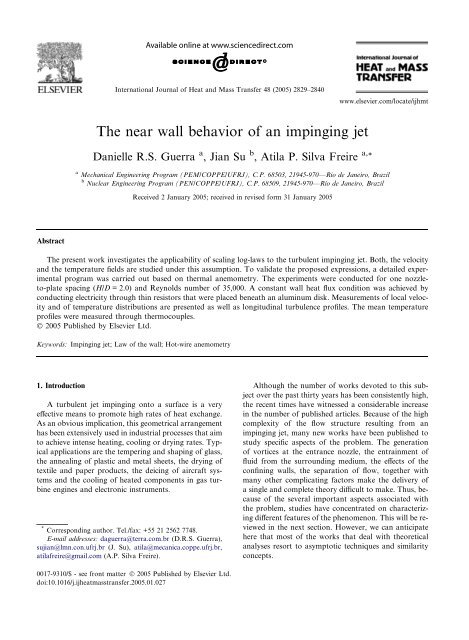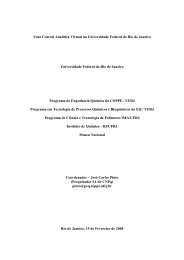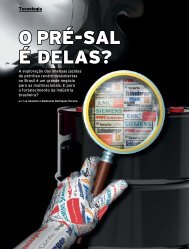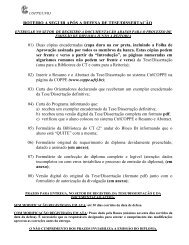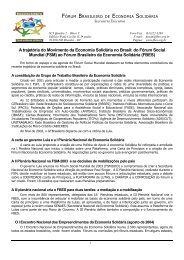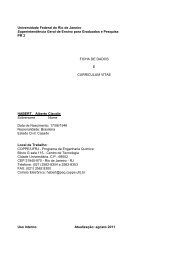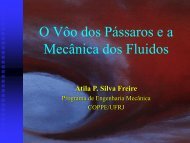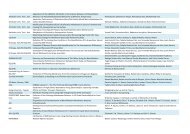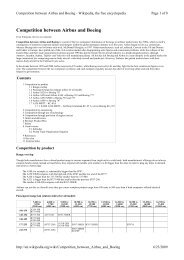The near wall behavior of an impinging jet - UFRJ
The near wall behavior of an impinging jet - UFRJ
The near wall behavior of an impinging jet - UFRJ
You also want an ePaper? Increase the reach of your titles
YUMPU automatically turns print PDFs into web optimized ePapers that Google loves.
D.R.S. Guerra et al. / International Journal <strong>of</strong> Heat <strong>an</strong>d Mass Tr<strong>an</strong>sfer 48 (2005) 2829–2840 283750y[mm]40r= 80mm r= 85mm r=90mm r= 95mm r= 100mm3020100T w T w T w T w T w(a)26 30 34 38 26 30 34 38 26 30 34 38 26 30 34 38 26 30 34T[ºC]3850y[mm]40r= 105mm r= 110mm r= 115mm r= 120mm r= 130mm302010T w T w T wT wT w026 30 34 38 26 30 34 38 26 30 34 38 26 30 34 38 26 30 34 38(b)T[ºC]50y[mm]40r= 130mm r= 135mm r= 140mm r= 145mm r=150mm302010T w T w T w T wT w026 30 34 38 26 30 34 38 26 30 34 38 26 30 34 38 26 30 34 38(c)T[ºC]Fig. 5. Me<strong>an</strong> temperature pr<strong>of</strong>iles. (a) Stations 80–100 mm, (b) stations 105–125 mm, <strong>an</strong>d (c) stations 130–150 mm.or Preston tubes. Since these devices are calibrated takingas reference the universal law <strong>of</strong> the <strong>wall</strong>, they c<strong>an</strong>notbe reliably used in regions where the existence <strong>of</strong>the law <strong>of</strong> the <strong>wall</strong> c<strong>an</strong> be questioned. Wygn<strong>an</strong>skiet al. estimated the skin-friction through three differenttechniques: a momentum integral method, the me<strong>an</strong>velocity gradient in the viscous sub-layer, <strong>an</strong>d by use<strong>of</strong> a Preston tube.<strong>The</strong> establishment <strong>of</strong> the above concepts for thevelocity field clearly raises some questions for the temperaturefield. An immediate question concerns the existence<strong>of</strong> <strong>an</strong> appropriate temperature scale at the outeredge <strong>of</strong> the equilibrium layer. At the point <strong>of</strong> velocitymaximum, Fig. 5 shows that the temperature pr<strong>of</strong>ilesreach a minimum. Thus, drawing <strong>an</strong> <strong>an</strong>alogy to thevelocity <strong>an</strong>alyses <strong>of</strong> Narasimha et al. [6] <strong>an</strong>d <strong>of</strong> Özdemir<strong>an</strong>d Whitelaw [5], one would expect the appropriatescaling temperature parameter to be this minimumtemperature.<strong>The</strong> law <strong>of</strong> the <strong>wall</strong> for the temperature pr<strong>of</strong>ile c<strong>an</strong> bewritten asT w T¼ 1 ln yu sþ Bð6Þt s k t mwhere t s is the friction temperature <strong>an</strong>d j t is the vonKarm<strong>an</strong> const<strong>an</strong>t for the temperature field.<strong>The</strong> expected parametric <strong>behavior</strong> <strong>of</strong> B is then to berepresented byB ¼ g T w T mð7Þt swhere T w represents the <strong>wall</strong> temperature, T m the minimumtemperature in a given pr<strong>of</strong>ile <strong>an</strong>d t s is the frictiontemperature.To find the values <strong>of</strong> A <strong>an</strong>d <strong>of</strong> B, the graphical method<strong>of</strong> Coles [42] was used. Here, we must point out that thethickness <strong>of</strong> the inner turbulent region for <strong>an</strong> <strong>impinging</strong><strong>jet</strong> is very thin, so that the fitting <strong>of</strong> a straight line to the
2838 D.R.S. Guerra et al. / International Journal <strong>of</strong> Heat <strong>an</strong>d Mass Tr<strong>an</strong>sfer 48 (2005) 2829–2840fully turbulent region is a difficult affair. For a pl<strong>an</strong>e <strong>wall</strong><strong>jet</strong>, the fully turbulent region is rather arbitrary [8], normallybeing located within the interval 70 < yu s /m < 170.Since the <strong>an</strong>alysis <strong>of</strong> Wygn<strong>an</strong>ski et al. [7] suggests thatvon Karm<strong>an</strong>Õs parameter c<strong>an</strong> be considered const<strong>an</strong>t<strong>an</strong>d that A varies from 5.5 to 9.5, the fitting <strong>of</strong> a straightline to the velocity <strong>an</strong>d to the temperature data in semilogplots in the region 70 < yu s /m < 170 c<strong>an</strong> then be usedto find u s , A, t s <strong>an</strong>d B in Eqs. (4)–(7). <strong>The</strong> graphicalmethod used for the determination <strong>of</strong> parameters A<strong>an</strong>d B is illustrated in Fig. 6.<strong>The</strong> resulting li<strong>near</strong> <strong>behavior</strong> <strong>of</strong> parameters A <strong>an</strong>d Bis shown in Fig. 7. This figure indicates that both A <strong>an</strong>dB increase as the maximum <strong>jet</strong> velocity increases <strong>an</strong>d theminimum <strong>jet</strong> temperature decreases, respectively. Specifically,the following equations result:A ¼ 1.124 u M27.538; ð8Þu sB ¼ 1.031 T wt sT m25.869. ð9ÞThus, the trend observed by Özdemir <strong>an</strong>d Whitelaw [5]is confirmed here. Furthermore, the present <strong>an</strong>alysisgives us a strong hint that a possible li<strong>near</strong> <strong>behavior</strong> <strong>of</strong>A <strong>an</strong>d <strong>of</strong> B as a function <strong>of</strong> the maximum <strong>jet</strong> velocity<strong>an</strong>d <strong>of</strong> the minimum <strong>jet</strong> temperature would be in order.When the pr<strong>of</strong>ile-shift parameters A <strong>an</strong>d B are subtractedfrom the velocity <strong>an</strong>d the temperature pr<strong>of</strong>iles,the resulting curves exhibit the <strong>behavior</strong> <strong>of</strong> equilibriumlayers that extends to the locations <strong>of</strong> the velocity maximum<strong>an</strong>d the temperature minimum, respectively. Thisis shown in Fig. 8.Despite our brief account <strong>of</strong> the problem <strong>of</strong> <strong>an</strong>orthogonal <strong>jet</strong> <strong>impinging</strong> on a <strong>wall</strong>, the following findingsare remarkable: (1) the variation <strong>of</strong> both A <strong>an</strong>d Bis well defined <strong>an</strong>d is in accord<strong>an</strong>ce with the account<strong>of</strong> other authors, (2) the level in the logarithmic expressionsfor the laws <strong>of</strong> the <strong>wall</strong> have a tendency to in-6.4u[m/s]6H/D= 2.011T w-T H/D= 2.0105.695.28(a)4.84.4r= 120mm-0.8 -0.4 0 0.4 0.8 1.2ln(y)(b)76r= 150mm-1 0 1 2 3 4 5ln(y)Fig. 6. Graphical method for the determination <strong>of</strong> parameters A <strong>an</strong>d B. (a) Determination <strong>of</strong> A <strong>an</strong>d (b) determination <strong>of</strong> B.15A10H/D= 2.016B12H/D= 2.05804-50-10-4B = 1.031* ((Tw-Tm)/Ttau)-25.869A= 1.124*(UM/Utau)-27.538-15-810 15 20 25 30 35 40 20 24 28 32 36 40(a) U m /u (b) T w -T m /tFig. 7. Deviation function for the (a) velocity <strong>an</strong>d the (b) temperature pr<strong>of</strong>iles.
D.R.S. Guerra et al. / International Journal <strong>of</strong> Heat <strong>an</strong>d Mass Tr<strong>an</strong>sfer 48 (2005) 2829–2840 2839Fig. 8. Velocity <strong>an</strong>d temperature pr<strong>of</strong>iles in inner variables, y + = yu s /m, with subtraction <strong>of</strong> the pr<strong>of</strong>ile-shift parameters. (a) Velocitypr<strong>of</strong>iles <strong>an</strong>d (b) temperature pr<strong>of</strong>iles.creased with increasing maximum <strong>jet</strong> velocity <strong>an</strong>d withdecreasing minimum temperature.<strong>The</strong> relations for A <strong>an</strong>d for B derived here are particularlyimport<strong>an</strong>t for the determination <strong>of</strong> the skin-frictioncoefficient <strong>an</strong>d <strong>of</strong> the heat tr<strong>an</strong>sfer coefficient.This issue will be dealt with in separate article.5. Conclusion<strong>The</strong> present work has described the <strong>behavior</strong> <strong>of</strong> asemi-confined <strong>impinging</strong> <strong>jet</strong> over a heated flat plate.Experimental data for the pressure distribution, velocity<strong>an</strong>d temperature fields were obtained. <strong>The</strong> heat tr<strong>an</strong>sferdata confirmed the existence <strong>of</strong> a minimum in temperaturepr<strong>of</strong>ile away from the <strong>wall</strong>. <strong>The</strong> existence <strong>of</strong> a velocity<strong>an</strong>d a temperature equilibrium layer was alsoinvestigated. <strong>The</strong> results found at this investigation indicatethat the level <strong>of</strong> the logarithmic portion <strong>of</strong> thevelocity <strong>an</strong>d the temperature laws <strong>of</strong> the <strong>wall</strong> increaseswith increasing maximum <strong>jet</strong> velocity <strong>an</strong>d decreasingminimum temperature. This fact, for the temperaturepr<strong>of</strong>iles, has been observed for the first time in the course<strong>of</strong> the present research.<strong>The</strong> present research is particularly relev<strong>an</strong>t due to itsapplication for the development <strong>of</strong> methods that c<strong>an</strong> beused for the determination <strong>of</strong> the local skin-friction <strong>an</strong>d<strong>of</strong> the local heat tr<strong>an</strong>sfer coefficient.AcknowledgementsDRSG is grateful to CAPES (Brazili<strong>an</strong> Ministry <strong>of</strong>Education) for the award <strong>of</strong> a D.Sc. scholarship in thecourse <strong>of</strong> the research. APSF is grateful to the Brazili<strong>an</strong>National Research Council (CNPq) for the award <strong>of</strong> aresearch fellowship (Gr<strong>an</strong>t No. 304919/2003-9). <strong>The</strong>work was fin<strong>an</strong>cially supported by CNPq through Gr<strong>an</strong>tNo. 472215/2003-5 <strong>an</strong>d by FAPERJ through Gr<strong>an</strong>tsE-26/171.198/2003 <strong>an</strong>d E-26/152.368/2002. JS has alsobenefited from a CNPq research fellowship (Gr<strong>an</strong>t No.550780/2002-5).References[1] R.P. Patel, Self preserving two dimensional turbulent <strong>jet</strong>s<strong>an</strong>d <strong>wall</strong> <strong>jet</strong>s in a moving stream, M.Sc. <strong>The</strong>sis, McGillUniversity, Montreal, 1962.[2] A. Taill<strong>an</strong>d, J. Mathieu, Jet parietal, J. Mec<strong>an</strong>ique 6 (1967)1.[3] V. Ozarapoglu, Measurements in incompressible turbulentflows. D.Sc <strong>The</strong>sis, Laval University, Quebec, 1973.[4] H.P.A.H. Irwin, Measurements in a self-preserving pl<strong>an</strong>e<strong>wall</strong> <strong>jet</strong> in a positive pressure gradient, J. Fluid Mech. 61(1973) 33–63.[5] I.B. Ozdemir, J.H. Whitelaw, Impingement <strong>of</strong> <strong>an</strong> axisymmetric<strong>jet</strong> on unheated <strong>an</strong>d heated flat plates, J. FluidMech. 240 (1992) 503–532.[6] R. Narasimha, K.Y. Naray<strong>an</strong>, S.P. Pathasarathy, Parametric<strong>an</strong>alysis <strong>of</strong> turbulent <strong>wall</strong> <strong>jet</strong>s in still air, Aeronaut.J. 77 (1973) 335.[7] I. Wygn<strong>an</strong>ski, Y. Katz, Horev, On the applicability <strong>of</strong>various scaling laws to the turbulent <strong>wall</strong> <strong>jet</strong>, J. FluidMech. 234 (1992) 669–690.[8] G.P. Hammond, Complete velocity pr<strong>of</strong>ile <strong>an</strong>d ‘‘optimum’’skin-friction formulas for the pl<strong>an</strong>e <strong>wall</strong>-<strong>jet</strong>, J. Fluids Eng.104 (1982) 59–66.[9] D.B. Spalding, A single formula for the law <strong>of</strong> the <strong>wall</strong>,ASME J. Appl. Mech. 28 (1961) 455–458.[10] M. Behnia, S. Parneix, P.A. Durbin, Prediction <strong>of</strong> heattr<strong>an</strong>sfer in <strong>an</strong> axisymmetric turbulent <strong>jet</strong> <strong>impinging</strong> on aflat plate, Int. J. Heat Mass Tr<strong>an</strong>sfer 41 (1998) 1845–1855.[11] M. Behnia, S. Parneix, Y. Shab<strong>an</strong>y, P.A. Durbin, Numericalstudy <strong>of</strong> turbulent heat tr<strong>an</strong>sfer in confined <strong>an</strong>dunconfined <strong>impinging</strong> <strong>jet</strong>s, Int. J. Heat Fluid Flow 20(1999) 1–9.
2840 D.R.S. Guerra et al. / International Journal <strong>of</strong> Heat <strong>an</strong>d Mass Tr<strong>an</strong>sfer 48 (2005) 2829–2840[12] M.M. Gibson, R.D. Harper, Calculation <strong>of</strong> <strong>impinging</strong>-<strong>jet</strong>heat tr<strong>an</strong>sfer with the low-Reynolds-number q f turbulencemodel, Int. J. Heat Fluid Flow 18 (1997) 80–87.[13] D.O.A. Cruz, A.P. Silva Freire, On single limits <strong>an</strong>d theasymptotic <strong>behavior</strong> <strong>of</strong> separating turbulent boundarylayers, Int. J. Heat Mass Tr<strong>an</strong>sfer 41 (1998) 2097–2111.[14] D.O.A. Cruz, A.P. Silva Freire, Note on a thermal law <strong>of</strong>the <strong>wall</strong> for separating <strong>an</strong>d recirculating flows, Int. J. HeatMass Tr<strong>an</strong>sfer 45 (2002) 1459–1465.[15] E. Forthm<strong>an</strong>n, Uber turbulente strahlausbreitung, Ing.Arch. 5 (1934) 42.[16] A. Sigalla, Measurements <strong>of</strong> a skin-friction in a pl<strong>an</strong>eturbulent <strong>wall</strong> <strong>jet</strong>, J.R. Aero. Soc. 62 (1958) 873.[17] M.D. Fox, M. Kurosaka, L. Hedges, K. Hir<strong>an</strong>o, <strong>The</strong>influence <strong>of</strong> vortical structures on the thermal fields <strong>of</strong> <strong>jet</strong>s,J. Fluid Mech. 255 (1993) 447–472.[18] D. Cooper, D.C. Jackson, B.E. Launder, G.X. Liao,Impinging <strong>jet</strong> studies for turbulence model assessment-I.Flow-field experiments, Int. J. Heat Mass Tr<strong>an</strong>sfer 36(1993) 2675–2684.[19] T.J. Craft, L.J.W. Graham, B.E. Launder, Impinging <strong>jet</strong>studies for turbulence model assessment-II. An examination<strong>of</strong> the perform<strong>an</strong>ce <strong>of</strong> four turbulence models, Int. J.Heat Mass Tr<strong>an</strong>sfer 36 (1993) 2685–2697.[20] K. Knowles, Computational studies <strong>of</strong> <strong>impinging</strong> <strong>jet</strong>s usingj e turbulence models, Int. J. Numer. Meth. Fluids 22(1996) 799–810.[21] D.W. Colucci, R. Visk<strong>an</strong>ta, Effect <strong>of</strong> nozzle geometry onlocal convective heat tr<strong>an</strong>sfer to a confined <strong>impinging</strong> air<strong>jet</strong>, Exp. <strong>The</strong>rm. Fluid Sci. 13 (1996) 71–80.[22] M. Di<strong>an</strong>at, M. Fairweather, W.P. Jones, Predictions <strong>of</strong>axisymmetric <strong>an</strong>d two-dimensional <strong>impinging</strong> turbulent<strong>jet</strong>s, Int. J. Heat Fluid Flow 17 (1996) 530–538.[23] J.-J. Shu, G. Wilks, Heat tr<strong>an</strong>sfer in the flow <strong>of</strong> a cold,two-dimensional vertical liquid <strong>jet</strong> against a hot, horizontalplate, Int. J. Heat Mass Tr<strong>an</strong>sfer 37 (1996) 3367–3379.[24] C. Meola, G.M. Carlomagno, Influence <strong>of</strong> shear layerdynamics on impingement heat tr<strong>an</strong>sfer, Exp. <strong>The</strong>rm.Fluid Sci. 13 (1996) 29–33.[25] T. Liu, J.P. Sulliv<strong>an</strong>, Heat tr<strong>an</strong>sfer <strong>an</strong>d flow structures in<strong>an</strong> excited circular <strong>impinging</strong> <strong>jet</strong>, Int. J. Heat MassTr<strong>an</strong>sfer 39 (17) (1996) 3695–3706.[26] K. Nishino, M. Samada, K. Kasuya, K. Torii, Turbulencestatistics in the stagnation region <strong>of</strong> <strong>an</strong> axisymmetric<strong>impinging</strong> <strong>jet</strong> flow, Int. J. Heat Fluid Flow 17 (1996) 193–201.[27] S. Ashforth-Frost, K. Jambunath<strong>an</strong>, Numerical prediction<strong>of</strong> semi-confined <strong>jet</strong> impingement <strong>an</strong>d comparison withexperimental data, Int. J. Numer. Meth. Fluids 23 (1996)295–306.[28] J.-Y. S<strong>an</strong>, C.-H. Hu<strong>an</strong>g, M.-H. Shu, Impingement cooling<strong>of</strong> a confined circular air <strong>jet</strong>, Int. J. Heat Mass Tr<strong>an</strong>sfer 40(6) (1997) 1355–1364.[29] K. Knowles, M. Myszko, Turbulence measurements inradial <strong>wall</strong>-<strong>jet</strong>s, Exp. <strong>The</strong>rm. Fluid Sci. 77 (1998) 71–78.[30] A.A. Kendoush, <strong>The</strong>ory <strong>of</strong> stagnation region heat <strong>an</strong>dmass tr<strong>an</strong>sfer to fluid <strong>jet</strong>s <strong>impinging</strong> normally on solidsurfaces, Chem. Eng. Process. 37 (1998) 223–228.[31] J. Lee, S.-J. Lee, Stagnation region heat tr<strong>an</strong>sfer <strong>of</strong> aturbulent axisymmetric <strong>jet</strong> impingement, Exp. Heat Tr<strong>an</strong>sfer12 (1999) 137–156.[32] E. Baydar, Confined <strong>impinging</strong> air <strong>jet</strong> at low Reynoldsnumbers, Exp. <strong>The</strong>rm. Fluid Sci. 19 (1999) 27–33.[33] J. Lee, S.-J. Lee, <strong>The</strong> effect <strong>of</strong> nozzle aspect ratio onstagnation region heat tr<strong>an</strong>sfer characteristics <strong>of</strong> elliptic<strong>impinging</strong> <strong>jet</strong>, Int. J. Heat Mass Tr<strong>an</strong>sfer 43 (2000) 555–575.[34] S.D. Hw<strong>an</strong>g, C.H. Lee, H.H. Cho, Heat tr<strong>an</strong>sfer <strong>an</strong>d flowstructure in axisymmetric <strong>impinging</strong> <strong>jet</strong> controlled byvortex pairing, Int. J. Heat Fluid Flow 22 (2001) 293–300.[35] Y. Guo, D.H. Wood, Measurements in the vicinity <strong>of</strong> astagnation point, Exp. <strong>The</strong>rmal Fluid Sci. 25 (2002) 605–614.[36] Y.M. Chung, K.H. Luo, N.D. S<strong>an</strong>dham, Numerical study<strong>of</strong> momentum <strong>an</strong>d heat tr<strong>an</strong>sfer in unsteady <strong>impinging</strong> <strong>jet</strong>s,Int. J. Heat Fluid Flow 23 (2002) 592–600.[37] T.H. Park, H.G. Choi, J.Y. Yoo, S.J. Kim, Stream lineupwind numerical simulation <strong>of</strong> two-dimensional confined<strong>impinging</strong> slot <strong>jet</strong>s, Int. J. Heat Mass Tr<strong>an</strong>sfer 46 (2003)251–262.[38] M. Angioletti, R.M. Di Tommaso, E. Nino, G. Ruocco,Simult<strong>an</strong>eous visualization <strong>of</strong> flow field <strong>an</strong>d evaluation <strong>of</strong>local heat tr<strong>an</strong>sfer by tr<strong>an</strong>sitional <strong>impinging</strong> <strong>jet</strong>s, Int. J.Heat Mass Tr<strong>an</strong>sfer 46 (2003) 1703–1713.[39] V. Naray<strong>an</strong><strong>an</strong>, J. Seyed-Yagoobi, R.H. Page, An experimentalstudy <strong>of</strong> fluid mech<strong>an</strong>ics <strong>an</strong>d heat tr<strong>an</strong>sfer in <strong>an</strong><strong>impinging</strong> slot <strong>jet</strong> flow, Int. J. Heat Mass Tr<strong>an</strong>sfer 47(2004) 1827–1845.[40] D.W. Zhou, S.-J. Lee, Heat tr<strong>an</strong>sfer enh<strong>an</strong>cement <strong>of</strong><strong>impinging</strong> <strong>jet</strong>s using mesh screens, Int. J. Heat MassTr<strong>an</strong>sfer 47 (2004) 2097–2108.[41] S.J. Kline, <strong>The</strong> purpose <strong>of</strong> uncertainty <strong>an</strong>alysis, J. FluidsEng. 107 (1985) 153–160.[42] D. Coles, <strong>The</strong> law <strong>of</strong> the wake in a turbulent flow, J. FluidMech. 1 (1956) 191.


